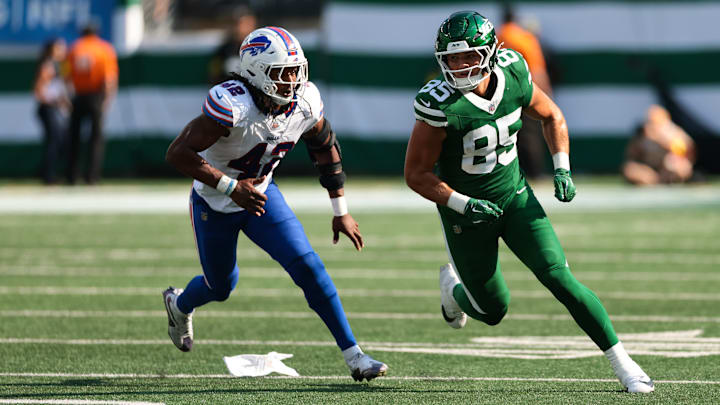The New York Jets have had a complicated relationship with tight ends over the last 30 years. The tight end position was responsible for one of the biggest blunders in Jets history when the franchise selected Kyle Brady instead of Hall of Famer Warren Sapp.
Since that moment, the position has been a sea of ineptitude, at least as far as receiving production goes, save for a brief moment of brightness with Dustin Keller during the franchise's last golden era.
The team has also been cursed when selecting receiving playmakers in the second round, as Stephen Hill, Devin Smith, Denzel Mims, and Elijah Moore can attest. Jace Amaro, too, when you count tight ends among the receiving threats the Jets have selected in the second round over the last couple of decades.
That's why, despite high expectations and some impressive NFL bloodlines, some were skeptical about the second-round rookie tight end.
Jets rookie Mason Taylor's performance presents a silver lining in a frustrating loss against the Dolphins
Taking on the then-winless Dolphins provided the Jets with their best opportunity to get into the win column themselves. After dramatically snatching defeat from the jaws of victory in Week 3 against the Buccaneers, the hope was that New York could ride the momentum while taking advantage of Miami's freefall.
A turnover, penalty-filled, referee-aided mess ensued. Same old Jets, again.
While there were a lot of negative takeaways from the lackluster showing, the performance of Mason Taylor wasn't one of them. In preparation for Monday night's matchup, head coach Aaron Glenn made it clear that the Jets needed to get Taylor more involved in the offense.
They did just that. And the rookie delivered.
Taylor wasn't lacking for snaps over the first few weeks of the season, playing 56 in Week 1, 34 in Week 2, and 51 in Week 3, but he wasn't given many opportunities to show off his receiving chops.
Over the first two weeks of the season, Taylor was targeted just three times. In Week 3, he received five targets, but with an average depth of target of just 2.2 yards, he was more of an emergency checkdown option rather than a schemed threat.
That changed in Week 4. Taylor was targeted seven times, hauling in five catches for 65 yards. With an average depth of target of 7.4 yards, he finally had actual plays designed for him. He delivered, racking up an average of 4.6 yards after the catch per reception.
There was also a schematic adjustment with Taylor. The Jets lined him up in the slot on 44.1% of his snaps, exploiting matchups where the LSU product's size becomes a factor against smaller defensive backs, while taking advantage of his athletic gifts to neutralize the speed advantage that the smaller defenders typically have on a tight end.
This will be something to watch moving forward. The Jets' wide receivers, not named Garrett Wilson, have combined for a total of 12 catches for 112 yards. That's an average of three receptions and 28 yards per game from the quartet of Allen Lazard, Josh Reynolds, Arian Smith, and Tyler Johnson.
Those four have also struggled to get open, generating just 19 targets through four weeks versus 35 for Wilson alone. That abysmal showing highlights just how desperately the team needs a running mate for Wilson in the passing game.
By lining up Taylor in the slot, the Jets not only take advantage of the matchup problem he creates, but they also take an inferior player off the field.
Tight end has a notoriously large learning curve transitioning from college to the pros. One promising game doesn't mean that Taylor has arrived. But his showing, combined with the interesting usage, should provide some optimism and make him a player to watch even if the season continues to spiral into the abyss.
